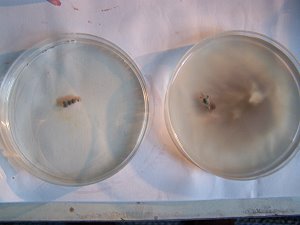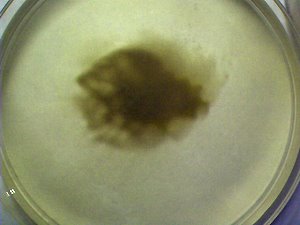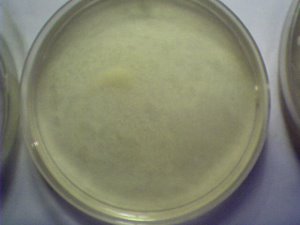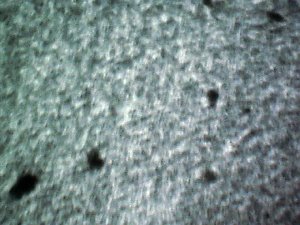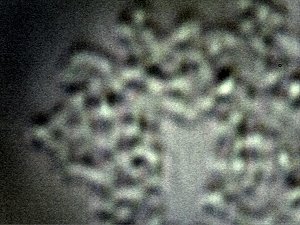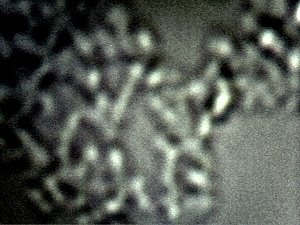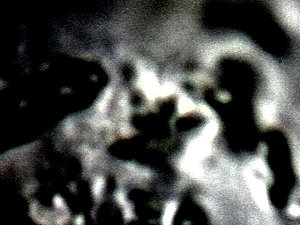MORGELLONS :
A DISCOVERY AND A PROPOSAL
Clifford E Carnicom
Feb 22 2010
Edited Jun 02 2011
Edited Jun 12 2011
Note: I am not offering any medical advice or diagnosis with the presentation of this information. I am acting solely as an independent researcher providing the results of extended observation and analysis of unusual biological conditions that are evident. Each individual must work with their own health professional to establish any appropriate course of action and any health related comments in this paper are solely for informational purposes and they are from my own perspective.
A set of conditions that leads to the enhanced growth of the “bacterial-like” components of the cultures under study has been identified. This will be referred to as the discovery aspect of this paper.
A set of conditions that apparently leads to the inhibition of the growth of the “bacterial-like” components has also been identified. This will be referred to as the proposal aspect of this paper.
These bacterial-like forms comprise two of the four primary components that have been repeatedly identified as being distinctly characteristic of the so-called “Morgellons’s condition. The additional two forms are that of the filament and erythrocytic forms, respectively, as enumerated within numerous earlier papers (e.g., Morgellons : A New Classification). The bacterial-like forms are at the crux of the research on this condition, as they appear to be the precursors and prerequisites to the matured development that encompasses all four forms. The existence of the bacterial-like (chlamydia-like and mycoplasma-like) forms can only be established with certainty at sufficient microscopic examination (approximately 10,000x).
DISCOVERY
Now for additional details on the discovery aspect of this paper. A general statement will be made, and then I will expand upon this statement with additional information:
“Given that a hydroxyl free radical exists within an acidic environment with sufficient nutrients, the growth of the Morgellons bacterial-like organisms in that same medium will increase rapidly in the presence of oxidizers.”
Let us now discuss how this statement has evolved and what it means.
Hundreds of various culture trials have been analyzed over the past several months since it was learned that the four components (as a minimum) can be cultivated in a controlled environment external to the body. These culture studies continue. It is these cultures that have allowed many conclusions and inferences to be drawn on various aspects that affect the growth of the pathogens under study. Some of the aspects that have been considered include variation in the culture medium (agar, wines, simulated wines, broths, etc.), acid or alkalinity (pH), conductivity variation, ion analyses, nutrients and potential inhibitors to growth, for example. Some of the approaches and assessments have been reached through a combination of trial and error, experimentation and intuition; the majority of them have been reached through the prolonged and progressive accumulation of various rationales and study. The general statement above has been reached through a combination of all of the above.
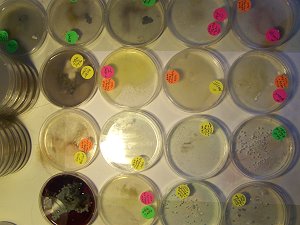
Culture Trials Under Examination
Rather than detail all of the various combinations that have been evaluated over the many preceding months, let us focus now on more recent developments that seem to be especially important with respect to the growth and the inhibition of the pathogens.
One of the changes that has occurred during the last several weeks is to shift the majority of the cultures to the use of white wines instead of red wines. Solution based chemistry by itself has many advantages, but one of the needs that has arisen is to develop a colorless or clear solution based culture so that analysis and observation become more straightforward. This idea was successful and numerous advantages have resulted from this switch. In addition, we learn that growth, at least at the preliminary stages, is not affected by whether a red wine or a white wine is involved (i.e., tannin consideration, etc.). Indeed, a “simulated wine” culture has also been developed with some success, and this has the extended advantage of being both transparent and of known chemical composition. This level of control may become even more important in the future, but for the time being, white wines are simple to use and accomplish the immediate purpose. Red wines have the known advantage of being able to produce the culminating filament form; not enough time has elapsed yet to determine if this remains the case for white wines. Agar cultures were the first to be developed some time ago, but they offer no distinct advantages at this time.
The next item to consider is the role of iron. It may be recalled from earlier reports that an interest in potential iron consumption and the metabolism of iron has been expressed. This remains the case. The cultures will grow in white wine alone, but the growth appears without doubt to be enhanced with the addition of a small amount of iron sulfate to the solution. During some of the trials that use a combination of white wine and iron sulfate, an additional component of hydrogen peroxide was introduced into the culture. It is at this point that a dramatic increase in the growth rate and extent of the culture was noted. Under these circumstances, it is not unusual to be able to record and observe the bacterial-like stage of growth occurring within a matter of hours. This is in major contrast to the use of wine alone, where a minimum of several days will usually be necessary. The filament growth stage generally takes anywhere from weeks to months to develop and it does seem in part to depend upon temperature.
This particular reaction of sudden growth is of much interest and it has deserved further and detailed consideration. As we delve into this question, a particular chemical reaction of note emerges, known as Fenton’s Reaction1,2 (discovered in 1894). The essence of Fenton’s reaction is as follows : the iron ion (+2) when added to hydrogen peroxide, forms the iron ion in the +3 state, the OH- ion (i.e., the hydroxide ion) and the OH (neutral) radical, also called the hydroxyl radical.
The hydroxyl radical (OH neutral) is of tremendous interest in our case. What is the ‘hydroxyl radical” and why is it important? The hydroxyl radical is what is known as a “free radical” and it has major implications in biology, health and disease. I am not a chemist by profession and those that are may choose to engage themselves; I continue to hope that they shall. I am, however, sufficiently motivated in a broad array of disciplines to seek answers to important questions and problems of need and we have more than enough of them for us all.
A free radical is a compound that in general seeks to react, because of an electron imbalance, with something else. In more technical terms, a free radical is a substance with one or more unpaired electrons.3 As one of many examples of the consequences of the this particular free radical, we note the following:
| “In cells and tissues, such particles can attack a host of surrounding biomolecules to produce new free radicals, which, in turn, attack yet other compounds. Thus, the formation of a single free radical can initiate a large number of chemical reactions that are ultimately able to disrupt the normal operations of cells”.4 |
Furthermore, this particular “Reactive Oxygen Species” (ROS) is just about at the top of the list in nature as essentially one of the most reactive oxidants known, only after Fluorine as shown in the following table:5
| Oxidant | Oxidation potential, V |
|---|---|
|
Fluorine |
3.0 |
|
Hydroxyl radical |
2.8 |
|
Ozone |
2.1 |
|
Hydrogen peroxide |
1.8 |
|
Potassium permanganate |
1.7 |
|
Chlorine dioxide |
1.5 |
|
Chlorine |
1.4 |
Oxidation is the process in which atoms, molecules or ions lose electrons. An oxidizing agent is a chemical reagent that oxidizes, or takes electrons away from other atoms, molecules or ions.6
Now that we know that the hydroxyl radical is extremely reactive (and damaging to biology), let us continue to make sense of that which has been observed. Fenton’s reaction is self-standing, and it does not need the culture to exist. Fenton’s reaction is a reaction that says if we have the iron ion present (+2) and if we have hydrogen peroxide available, we will end up with the hydroxyl radical formed. It does not say anything about the culture and what has been observed, i.e, an explosion of growth in the presence of Fenton’s reaction. What can be said about the culture is that if Fenton’s reaction takes place in the culture, then we have an explosion of growth that takes place. It is reasonable to surmise, then, that if the hydroxyl radical is present in the culture, that growth then takes off explosively. Now the question that comes up is whether or not we are likely to have the hydroxyl radical in our bodies. The answer is yes, as it is an expected product of metabolism.7,8
The next question that we must ask is whether or not the bacterial-like organisms occur commonly within the human species. There are numerous reports that address the reality of that situation, and it will simply be stated here that the evidence presents itself in the affirmative. It is reasonable, therefore, to suggest that the conditions for expanded growth of this organism set are likely to exist on a larger scale, and that we should realize the serious health issues that are likely to ensue.
There is, therefore, legitimate concern for certain health conditions that are likely to be prevalent. In addition, the specific chemical and biological conditions that underlie this concern may have in part been identified and established. The analysis of the conditions and the basis for the concern result from direct biological observation and study over an extended period of time. The basis for the analysis is an extensive set of culture studies that are a direct result of the research on the Morgellons condition.
An additional set of observations concerns the use of and presence of oxidizers, in general, within the culture environment (beyond that of hydrogen peroxide). It is found, in general, beyond that of Fenton’s reaction and the use of hydrogen peroxide, that oxidizers in general enhance the growth rate and extent of the cultures. These studies include additional items from the list above, such as chlorine and chlorine dioxide. Specifically, sodium hypochlorite (conventional bleach), sodium chlorite (may be sold as “MMS”) and calcium hypochlorite (may be sold as MMSII) all enhance the growth of the culture in the presence of an added iron solution. This observation raises serious questions, in the eyes of this researcher, as to whether increased growth of the “organisms” under study may in fact result from the use of chemicals of an oxidative nature (at least when used internally). Oxidation and the creation of free radicals with the use of chemical reagents in this family is an additional complication that is not appealing or attractive to me at this time. As one example of the concern held by a manufacturer (in this case, related to air filtration), it is stated that :
| “Some new air cleaning devices are using free radicals or Reactive Oxygen Species (ROS) to “oxidize” indoor air. Free radicals have been shown to be damaging to human health. Testing is lacking on the by-products of the reactions between free radicals and the components of indoor air.
[and from the same source:] Here is a quote from a brochure on another “cure-all for indoor air” product. It is a cause for concern. “When the HVAC system is in operation the cell creates an Advanced Oxidation Process consisting of Hydroxyl Radicals, Super Oxides, Hydroperoxides (Hydrogen Peroxide), UV light and ozonides (ozone).” It goes on to say: “All are friendly oxidizers. By friendly oxidizers we mean oxidizers that revert back to oxygen and hydrogen after the oxidation of the pollutant.” However, these are not “friendly oxidizers.” They are well known as Reactive Oxygen Species (ROS) or free radicals and are involved in a whole host of health problems from cancer to heart disease.“ 9 |
As a further clarification of the relationship between oxidation and free radicals, consider the following statement:10
| “Oxidation is a chemical reaction that transfers electrons from a substance to an oxidizing agent. Oxidation reactions can produce free radicals, which start chain reactions that damage cells. Antioxidants terminate these chain reactions by removing free radical intermediates, and inhibit other oxidation reactions by being oxidized themselves.” |
There is more that can be said here, particularly in respect to the health related issues of free radicals and in particular the hydroxyl radical. I, too, am in a continual state of learning. There are some individuals that state or claim, at an anecdotal level, that progress has resulted from the use of such oxidizing products. One immediate question that arises is whether we are referring to external or internal application. I will defer any assessment on this position until the research is at a more advanced state. I must, nevertheless, in the interest of time progress to the next issue, and that is the proposal that results from the current study.
PROPOSAL
Please recall the dogmatic qualification at the beginning of this report; no medical advice, diagnosis or assessment of any kind is being made here. I am making information available that you may or may not wish to consider in consultation with the health professional of your choosing.
The question that naturally arises when the growth of a culture is enhanced is whether or not this growth can be hindered, impeded or stopped. The ultimate desire is, of course, to kill the organism(s) without damaging the host. It is a formidable problem in this case. I understand the question and that millions across the globe may be or will be asking it. It is the natural and easy question to ask but, unfortunately, the answers may not be any more forthcoming than the tribulations that have brought us to the current state of knowledge. These inherent difficulties do not even begin to address the lack of proper resources to tackle the problem. It has always been my viewpoint that the proper means of addressing the current situation begins with the simple and factual identification of the particular “organisms” and environmental pollutants under study. Such an identification has not taken place and there is no real prospect of this occurring in a comprehensive and honest fashion in the immediate future. My thoughts on this subject are expressed rather thoroughly in the recent paper that I have referenced.11 It is hopeful that the central tenets of that paper can someday be proven wrong, but in the meantime, effort must be directed toward the more impending and obvious need for suppression of growth, at least within the culture environment that has been established. What I shall present here is a summary of the progress of the work in that direction. The general strategy to be employed is that the understanding of the conditions that support growth may well lead us to the eventual repression of that same growth.
We can begin the work on the problem by recalling a couple of the more salient observations that have been made.
In the culture environment, it has been established that the organism(s) flourish within an acidic environment. In addition, it has also been stated in earlier reports that many biochemical reactions only take place within a narrow pH [acid or alkaline] range12,13,14. Therefore, one of the first strategies to consider is to change the acidity or alkalinity of the growth environment and see if progress results. What has been observed in the cultures thus far is that an increase to the alkaline side does indeed appear to inhibit the growth of the culture. It does NOT “kill” the “organism(s)”, specifically the bacterial-like forms, but it does appear to put them into a state of dormancy or stasis. At this point, nothing can be stated to extinguish the organism(s) in their entirety. As has mentioned extensively in prior reports, the structures have been subjected to extreme chemical and heat conditions and the potential, if not the capability, to survive remains intact.
Nevertheless, potential dormancy is a preferable alternative to active growth. There is a great deal of literature in the health fields that extols the virtues and benefits of a shift to the alkaline side within the human diet and body. There are many individuals in these fields that emphatically declare that many diseases and ill conditions are a direct result of the acidic diet and acidic state of current generations. There are many resources that contrast alkaline diets in opposition to acidic diets, and it becomes difficult to argue with the merits of the foodstuffs of an alkaline diet15. There are health professionals that claim that the pH of the urine is one of the methods16 by which the body can be assessed with respect to its acidic or alkaline state and that discuss the respective health concerns that accompany the acidic condition. There are also some individuals that think that alkalizing the diet is a meaningless and worthless venture. The first part of the proposal, therefore, is that the effects of alkalizing the growth medium, be it a culture dish or the human body through a chosen diet, be considered as one potential mitigating factor to the damages that have been observed. I will leave it to the reader to pursue this avenue of research in consultation with the health professionals of their choice. If additional information in the laboratory setting becomes available that affects the specifics of the current observations, I will continue to make that information freely available.
Now let us talk further on the subjects of oxidation and free radicals, which brings us to the second aspect of the current “proposal”. The evidence at this point shows that oxidation, in general, increases the growth within the stated culture medium. The growth rate is quite dramatic and has been verified by observation under the microscope at high magnification. The chlamydia-like and mycoplasma-like forms grow explosively under the oxidative conditions that have been developed.
The obvious approach to reversing the results of oxidation is to consider the use of anti-oxidants.
At this time, a specific interest in seeking an anti-oxidant to the hydroxyl radical has been pursued. The topic of research is therefore, at this stage, that of seeking a “hydroxyl scavenger”, i.e,, a compound or agent that will combine with the free hydroxyl radical and form something that is inert or less damaging than the original radical. The work here has been conducted solely with the objective of reducing the growth rate within the culture medium. However, as in the case of alkalization of the diet and body, there are many health professionals that will pronounce the merits of anti-oxidants and their beneficial effects on human health. There is a plethora of literature and research on the effects of oxidation and free radicals to human health. This is also a subject that can be discussed and researched at great length; again I will have to forego this in the interest of time and progress to the reader.
Three such candidates have been identified in a search of the literature thus far; this list includes ascorbate, glycerin and “ester salts”. 17,18,19 It is anticipated that many other candidates will be added to the list if this research gains further momentum. The specific ester salt that has been developed and applied in this test case is sodium citrate; numerous potential candidates could be developed from the patent that has been referenced.
Note: Edit of Jun 02, 2011 – Please note this additional candidate and reference to be included in any future inhibition analysis, i.e., garlic compounds:“Abstract: The antioxidant properties of garlic compounds: allyl cysteine, alliin, allicin, and allyl disulfide.
Garlic and garlic extracts, through their antioxidant activities, have been reported to provide protection against free radical damage in the body. This study investigated antioxidant properties of garlic compounds representing the four main chemical classes, alliin, allyl cysteine, allyl disulfide, and allicin, prepared by chemical synthesis or purification. Alliin scavenged superoxide, while allyl cysteine and allyl disulfide did not react with superoxide. Allicin suppressed the formation of superoxide by the xanthine/xanthine oxidase system, probably via a thiol exchange mechanism. Alliin, allyl cysteine, and allyl disulfide all scavenged hydroxyl radicals; the rate constants calculated based on deoxyribose competitive assay were 1.4-1.7 x 10(10), 2.1-2.2 x 10(9), and 0.7-1.5 x 10(10) M (1) second(1), respectively. Contrary to previous reports, allicin did not exhibit hydroxyl radical scavenging activity in this study. Alliin, allicin, and allyl cysteine did not prevent induced microsomal lipid peroxidation, but both alliin and allyl cysteine were hydroxyl scavengers, and allyl disulfide was a lipid peroxidation terminator. In summary, our findings indicated that allyl disulfide, alliin, allicin, and allyl cysteine exhibit different patterns of antioxidant activities as protective compounds against free radical damage.20”
********************************************
Note: Edit of Jun 12, 2011 – Please note the role of bile in the alkalizing process and the role of the liver in toxin removal:
Please also become familiar with the following video presentations (no product endorsement or promotion by this site; educational purposes only):
Gallstones, Liver, Gallbladder, Kidney Cleanse Part 1
Gallstones, Liver, Gallbladder, Kidney Cleanse Part 2
Gallstones, Liver, Gallbladder, Kidney Cleanse Part 3
[“Gallstones, Liver, Gallbla…” The YouTube account associated with this video has been terminated due to multiple third-party notifications of copyright infringement.- 12/13/15]
The important question to be answered at this time is whether or not the application of such “hydroxyl scavengers” can suppress the growth rate within the culture. In the interest of brevity, I will report the results of the testing underway in a condensed fashion. This is a classic case where a set of photograph reveals more than can be written about under the circumstances. If additional time permits in the future, this discussion can be continued.
PHOTOGRAPHS – HYDROXYL RADICAL SCAVENGER TRIALS
|
A comparison of culture trials with and without antioxidants added. On the right side is a white wine culture medium with the filament stage (final stage) of the pathogenic form introduced. In addition, iron sulfate and hydrogen peroxide has been added. The growth of the culture (bacterial-like forms) in the culture on the right side is evident. Elapsed period approximately 24 hrs. On the left side are the same conditions as those on the right, except for the addition of three hydroxyl radical scavengers, as identified through a literature search. Vitamin C, glycerol (glycerin) and sodium citrate has been added to the culture preparation on the left side. Sodium citrate is strongly alkaline. No such rapid or extension of the bacterial-like growth has occurred in this trial. The antioxidant dosages used can be described at a later time, although in general repeated doses at regular intervals were required, and they were substantial relative to the mass of the entire culture. Once the growth reaction is in full progress, it appears difficult if not impossible to arrest. For any success in inhibiting growth, the antioxidants were required to be introduced at the same time that Fenton’s reaction is commenced, i.e., before the growth develops. |
A trial culture similar to that described in the photograph set to the left, with the exception that more time has elapsed. Several days have elapsed with the growth of the culture that is shown here (right side). There is no claim whatsoever that no growth of any kind occurs in the antioxidant trial (left culture dish); only that the growth of the culture does appear to be inhibited with the addition of these specific antioxidants. Determination of growth of any kind can only be determined at the microscopic level at sufficient magnification (~10,000x). It should also be stated that this represents the early stage of growth development (bacterial-like forms only) and that inhibition trials at the filament stage may represent an entirely different set of conditions. |
|
Another example of unrestrained growth of the culture without antioxidants. This culture differs from the above in that it uses a transfer from a filament culture that has been subjected to an alkali and heat, as described in earlier reports. The original source material is therefore presumed to in a “dormant” stage, and is primarily composed of the bacterial-like forms as opposed to the filament stage. |
This culture is again the same as on the left side of this set of photographs, with the exception of the addition of the three antioxidants mentioned. Each antioxidant alone appears to have some inhibitory effect, however the combination of all three antioxidants appears to be the most successful in suppressing growth. Additional extensive research is required to clarify the numerous variables of chemistry and metabolism that are in effect. |
|
An example of unrestrained growth at approx 300x. This magnification is sufficient to reveal only the gross structure of culture development. There is, however, a unique structural aspect that is characteristic of the growth than can be established with sufficient observation. |
The unrestrained growth of the culture at 10,000x. This high level magnification is required to uniquely identify the bacterial-like forms that are the subject of this and many previous reports. This photograph reveals primarily the pleomorphic form (mycoplasma-like) however the chlamydia-like form is also evident upon sufficient observation. |
Another example of unrestrained growth of the culture, not subjected to the three antioxidants. Magnification approx. 10,000x. |
|
An example of the growth that has been affected by or apparently restrained with the presence of the three hydroxyl scavengers mentioned : Vitamin C, glycerol and sodium citrate. Magnification approx. 300x. The antioxidants appear to create somewhat of a “precipitate” form and to alter or destroy the general structural integrity of the majority of the bacterial-like colonies. Again, absolutely no claim of termination of the bacterial-like forms is stated here; it does appear, that growth has been suppressed to some degree. |
An example of the restrained or altered growth with the addition of the hydroxyl radical scavengers at high magnification, approx, 10,000x. This photograph is appropriately compared with the one that is immediately above. Alteration to a precipitate like form reduces the level of detail at this high magnification. Evidence of extensive growth of the bacterial-like structures is not readily apparent. |
Another example of the altered or restrained growth at high magnification (~10,000x). Also appropriately compared with the two photographs immediately above. |
In summary, the discovery aspect of this paper identifies certain biological and chemical conditions that appear to be highly favorable to the growth of the bacterial-like organism(s) that are found to be in direct association with the so-called “Morgellons” condition. These chemical conditions include an acidic environment and the existence of the hydroxyl (OH neutral) free radical. When these conditions are met and various oxidizers are introduced into the culture, the growth is rapid and extensive at the bacterial-like level. The bacterial-like stage of growth represents the earlier stage in the development of the organism(s), and the culminating stage manifests as the filament form.
With respect to the proposal aspect of this paper, it is suggested that the state of acidity and alkalinity within the culture (or the body) be considered as a potential significant factor that is expected to affect the growth rate of the organism(s). It is established that growth of the organism(s) is favorable within an acidic environment, and there is strong evidence that an alkaline environment is suppressive to this growth. It is suggested that the benefits of an alkalizing diet and foodstuffs be evaluated with the appropriate health professionals, and that the extent of the acid-alkaline influence be thoroughly evaluated. A shift toward a more alkaline diet is not a trivial affair, and it is at odds with many of the dietary conventions of our generation.
Secondly, on the proposal aspect, it is suggested that the detrimental influences of free radicals and oxidation be researched thoroughly by all parties concerned. There is a particular interest in the hydroxyl free radical that has emerged from the current studies. It is also suggested that the benefits and effects of antioxidants be evaluated, both with respect to the particular conditions under examination here as well as with respect to general health. Again, health professionals of choice are to be consulted in any decisions that are to be made.
It is of interest that the proposals from this work are in accordance with much of the general consensus that has emerged with respect to improved health over the past decades. It is also apparent that the contemporary lifestyles and the environmental conditions that we find ourselves immersed in are, in many ways, in strong opposition to these guidelines of health. It is difficult to argue with the general benefits of a more alkaline diet and with the evidence that has emerged over decades with respect to free radical damage. It is true, however, that current habits of many of us are not in general accord with these very same principles and as a consequence contemporary society is often subject to its detriments.
It is quite obvious that the work before us is immense. As is common, many questions have emerged with any new findings. It should be apparent by now that such problems are not going to fix themselves or go away, and the sooner that we recognize the stakes of health and life that are at play, the sooner that we may prosper in that same health and good life. Once again, I call for your recognition of the seriousness of the issues, and for your participation in resolving them. Thank you.
Clifford E Carnicom
Feb 22, 2010
References:
1. Fenton’s Reaction, LennTech Water Treatment Solutions, http://www.lenntech.com/fenton-reaction.htm
2. Fenton’s Reagent, Wikipedia, http://en.wikipedia.org/wiki/Fenton_reaction
3.Chemistry, The Central Science, Theodore L. Brown, (2006, Pearson – Prentice Hall, 926.
4. Brown, 926.
5. Hydrogen Peroxide, Wikipedia, http://en.wikipedia.org/wiki/Hydrogen_peroxide
6. Oxidation, A-Z Chemistry, Andrew Hunt, (2003, McGraw-Hill, 259-260).
7. U.S. Patent 5965615 – Hydroxyl Radical Scavenger, Oct 12, 1999, Ivarrs Kalvinish.
8. Reactive Oxygen Species and Antioxidant Vitamins, Balz Frie, PhD, Director, Linus Pauling Institute, Professor of Biochemistry & Biophysics
9. Free Radicals Are NOT “Friendly Oxidizers, Jim Rosenthal, 3/27/2006, Allergy Clean Environments, http://allergyclean.com/news/5.htm
10. Antioxidants, Wikipedia, http://en.wikipedia.org/wiki/Antioxidant
11. Morgellons : A New Classification, Clifford E Carnicom, Feb 03, 2010, http://carnicominstitute.org/wp/morgellons-a-new-classification/
12. Biochemistry, Philip Kuchel, PhD, (2009, McGraw-Hill, 32).
13. Biochemistry for Dummies, John Moore, EdD, (2008, Wiley Publishing, 29).
14. Brown, Steven; Chemistry 102a Laboratory Manual, Kendall Hunt Publishing Company, 1996., p 125.
15. The Acid-Alkaline Food Guide, Dr. Susan E. Brown, (2006, Square One Publishers).
16. Dr Robert Young on How to Test Your Body Ph Levels , http://www.youtube.com/watch?v=UKP351Lcank
17. Inhibitory Effect of Antioxidants on Hydroxyl Radical Generation from Methylguanidine: An ESR Study, http://www.springerlink.com/content/xh722u1km160g5v5/
18. Dimethyl sulfoxide (DMSO) and glycerol, hydroxyl radical scavengers, impair platelet aggregation within and eliminate the accompanying vasodilation of, injured mouse pial arterioles, http://stroke.ahajournals.org/cgi/content/abstract/13/1/35
19. U.S. Patent 5965615, Kalvinish.
Edit Jun 02, 2011:
20. The antioxidant properties of garlic compounds: allyl cysteine, alliin, allicin, and allyl disulfide., National Insitutes of Health, http://www.ncbi.nlm.nih.gov/pubmed/16822206


